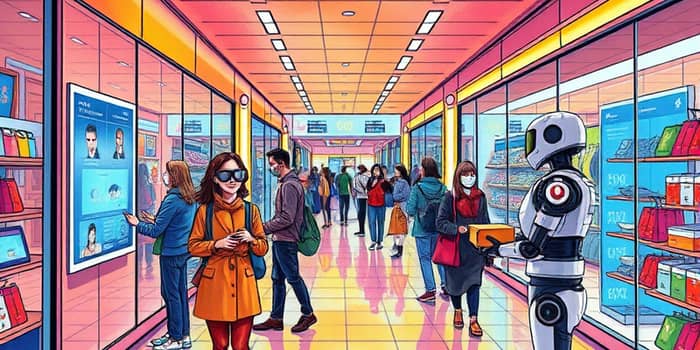In 2025, the retail industry stands at the threshold of unprecedented transformation, shaped by rapidly evolving consumer expectations and breakthroughs in technology. Retailers who embrace agility and bold innovation will forge deeper connections with their audiences and secure lasting success. This article delves into the key trends driving change and offers actionable insights to help brands adapt, thrive, and inspire in an era defined by digital and physical fusion.
Shifts in Consumer Behavior
The global pandemic accelerated lasting changes in how people discover, evaluate, and purchase products. Shoppers now expect swift, convenient, and consistent experiences whether they browse on mobile, order online, or visit a store. Even as e-commerce continues to flourish, the physical shop remains vital, with over 40 percent of consumers, particularly Gen Z, prioritizing the tactile engagement of in-store visits. Modern retailers must recognize this balance and craft seamless transitions between online and in-store to meet expectations and nurture loyalty.
Understanding these shifts means investing in customer research and data analytics to decode preferences, purchase drivers, and pain points. Retailers should harness feedback loops, social listening, and advanced segmentation to reveal nuanced behaviors across demographic and psychographic cohorts. By focusing on the human story behind each transaction, brands can deliver moments of delight, whether it’s a frictionless checkout, a personalized recommendation, or an inspirational in-store event.
Embracing Digital Transformation and Omnichannel
Digital transformation has moved from a buzzword to a business imperative. Forward-thinking retailers are building customer-centric, blended shopping journeys that integrate mobile apps, websites, and physical outlets into a unified ecosystem. Real-time inventory visibility, click-and-collect, and shoppable media campaigns are no longer optional—they are critical touchpoints that drive engagement and revenue. However, profitability challenges persist due to operational costs for picking, packing, and third-party logistics providers.
To address these challenges, businesses are exploring automation and in-house solutions. By developing proprietary micro-fulfillment centers, stores can handle orders more efficiently and reduce reliance on external partners. Simultaneously, investing in staff training and mobile point-of-sale tools enhances in-store efficiency and enables teams to respond quickly to customer needs. This holistic approach to omnichannel infrastructure ensures agility in both growth and risk management.
Leveraging AI and Personalization
Artificial intelligence and machine learning have unlocked an era of hyper-personalization. By analyzing purchase history, browsing patterns, and social engagement, retailers can tailor product recommendations, dynamic pricing, and targeted promotions at scale. Virtual appointments and immersive in-person experiences and demonstrations powered by AR/VR technologies are increasingly blurring the line between digital and brick-and-mortar shopping, driving higher conversion rates and deeper brand affinity.
Ethical data practices underpin these advances. With looming privacy regulations and growing consumer awareness, brands must adopt transparent data governance and secure user consent. Embracing ethical, privacy-first data strategies not only protects customers but also fosters trust and long-term loyalty, turning regulatory compliance into a competitive advantage.
Innovative Fulfillment and Delivery
Speed and convenience have become the currency of customer satisfaction. As 70 percent of retail executives plan to expand in-house delivery services, and 64 percent anticipate growth in state-of-the-art autonomous micro-fulfillment centers, the logistics landscape is transforming. Automated storage and retrieval systems, robotic pickers, and smart lockers enable same-day or even one-hour delivery windows, raising the bar for service quality.
Yet, offering rapid delivery without sacrificing profitability demands creative cost management. Retailers can optimize routes using AI-driven logistics software, negotiate volume-based rates with carriers, and introduce tiered delivery options. Moreover, simplifying the return process through prepaid labels and drop-off networks reduces friction and cultivates customer confidence, with research showing free returns significantly boost repeat purchases.
Phygital and Hybrid Experiences
The phygital model represents the fusion of physical and digital channels to create memorable engagements. From RFID-enabled fitting rooms that suggest complementary items to mobile apps that guide customers through interactive store tours, retailers are prioritizing rapid adaptation and bold innovation to delight shoppers. These hybrid experiences not only enhance convenience but also spark inspiration and social sharing, reinforcing brand narratives in a crowded market.
New Revenue Streams and Retail Media
In an environment of tight margins, alternative revenue streams are gaining traction. Retail media networks, in-store brand activations, and sponsored product placements allow retailers to monetize attention and data assets. By offering brands targeted access to engaged audiences, retailers diversify their income and strengthen partnerships. This symbiotic ecosystem benefits all stakeholders, driving both top-line growth and deeper consumer insights.
Building Resilience and Agility
The path to sustained success in 2025 requires more than innovation—retailers must be resilient and agile. From economic uncertainty to supply chain disruptions, the ability to pivot quickly in response to external shocks is essential. Establishing cross-functional teams, streamlining decision-making processes, and maintaining flexible inventory buffers enable organizations to navigate volatility without compromising customer experience.
Examples and Case Studies
Real-world success stories illuminate the possibilities of an evolved retail model. Here are a few standout examples:
- Target: The Drive Up service integrates Apple CarPlay for curbside pickup, offering real-time updates and intuitive navigation to streamline customer journeys.
- Zara: By equipping fitting rooms with RFID sensors and mobile reservation features, Zara delivers accurate stock visibility and reduces wait times.
- Sephora: Its in-store AR stations and virtual artist app combine to create engaging, frictionless, and inspiration-led paths to purchase, boosting both loyalty and average order value.
- Kendra Scott: The augmented reality try-on feature increases conversion rates by over 200 percent, illustrating the power of virtual product visualization.
Key Statistics
Below is a summary of the most compelling data points shaping the sector in 2025.
Conclusion
As the retail sector hurtles forward, success belongs to those who reconcile technology with human-centric design, innovation with ethics, and ambition with resilience. By weaving together digital and physical retail through omnichannel platforms, AI-driven personalization, and agile fulfillment strategies, retailers can craft compelling brand stories and enduring customer relationships.
Embrace this moment of opportunity, invest in meaningful innovation, and place consumer experience at the heart of every decision. In doing so, you will not only adapt to the new consumer trends but also pioneer the future of retail, inspiring loyalty and growth for years to come.
References
- https://www2.deloitte.com/us/en/insights/industry/retail-distribution/retail-distribution-industry-outlook.html
- https://nrf.com/blog/25-predictions-for-the-retail-industry-in-2025
- https://www.westrock.com/blog/the-top-retail-industry-trends-of-2025
- https://www.deloitte.com/dk/en/Industries/consumer/perspectives/retail-trends.html
- https://www.retaildive.com/spons/the-future-of-shopping-3-trends-that-will-define-2025/736225/
- https://www.gwi.com/blog/retail-trends
- https://www.mckinsey.com/industries/retail/our-insights/adapting-to-the-next-normal-in-retail-the-customer-experience-imperative
- https://www.colliers.com/en/research/nrep-usret-winter-retail-forecast-report-2024










